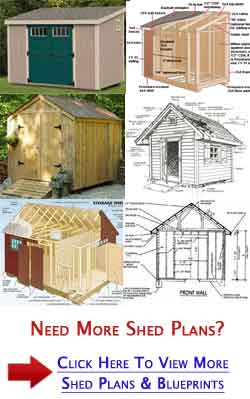

![Cedarshed studio 12x6 shed [st126]](https://i0.wp.com/www.shednation.com/oscthumb.php?src=/images/cedarshed/cedarshed-studio-shed-st96-1.jpg&w=1500&h=1220&f=jpg&q=95&hash=a1b196bdc5513eb64d7a831305149a4c) www.shednation.com ```html
www.shednation.com ```html Introduction: Building Your Own Lean-To Shed A lean-to shed is a fantastic addition to any property, providing extra storage space while utilizing an existing wall, such as the side of your house or garage. This guide will walk you through the process of building your own lean-to shed, step-by-step, from planning and gathering materials to the final touches. With a little effort and these instructions, you can create a functional and cost-effective storage solution.
Step 1: Planning and Preparation Before you begin construction, careful planning is essential. This involves determining the shed's size, obtaining necessary permits (check local regulations), and creating a detailed plan. Measure and mark the area where you intend to build the shed. Consider the available space and the purpose of the shed when determining its dimensions. Obtain any necessary building permits from your local municipality. These often depend on the size and location of the shed. Create a detailed plan, including dimensions, materials list, and construction steps. This will serve as your blueprint during the building process. Include information on foundation type (concrete slab, gravel pad, or wooden skid).
Step 2: Gathering Materials and Tools Once you have a plan, gather all the necessary materials and tools. A comprehensive list will help avoid delays during construction. Lumber: Pressure-treated lumber for the foundation, framing lumber (2x4s or 2x6s depending on size and load), and sheathing (plywood or OSB). Roofing materials: Shingles, roofing felt, nails, drip edge. Siding: Wood siding, vinyl siding, or other preferred material. Fasteners: Nails, screws, bolts, and anchors appropriate for your chosen materials and foundation. Concrete (if building a slab foundation) or gravel (if building a gravel pad). Door and hardware: Shed door, hinges, latch, and handle. Tools: Saw (circular saw or miter saw), drill, level, measuring tape, hammer, square, safety glasses, work gloves.
Step 3: Building the Foundation The foundation is crucial for the shed's stability and longevity. Choose the foundation type that best suits your needs and budget. Concrete Slab: Pour a concrete slab according to your plan's dimensions. Ensure it's level and properly cured before proceeding. This provides the most stable foundation. Gravel Pad: Excavate the area to the desired depth (4-6 inches). Compact the soil and fill with compacted gravel. This provides good drainage and a stable base. Wooden Skid Foundation: Construct a frame from pressure-treated lumber. Place the frame directly on the ground or on concrete blocks for added height and stability. This is a simpler option, but may not be suitable for larger sheds.
Step 4: Framing the Walls With the foundation in place, begin framing the walls. Build the wall frames using your plan as a guide. Cut the lumber to the correct lengths and assemble the frames using nails or screws. Include studs every 16 or 24 inches on center. Attach the top and bottom plates to the studs. Ensure the frames are square before securing them. The existing structure (house or garage) acts as one wall. You only need to frame the remaining three walls. Raise the wall frames and attach them to the foundation. Use temporary bracing to keep them plumb until the sheathing is installed. Attach the wall frames to the existing structure using appropriate fasteners. Ensure a secure connection.
Step 5: Installing Sheathing and Siding Adding sheathing to the walls provides structural integrity and a surface for attaching siding. Attach plywood or OSB sheathing to the outside of the wall frames using nails or screws. Ensure the sheathing is flush with the framing. Cover the sheathing with your chosen siding material, following the manufacturer's instructions. Overlap the siding properly to prevent water penetration. Cut openings for the door and any windows you may want to include.
Step 6: Building the Roof The roof protects the shed from the elements. Determine the roof pitch and cut the rafters accordingly. A lean-to shed typically has a single-sloped roof. Attach the rafters to the top plate of the walls, ensuring they are evenly spaced and securely fastened. Install sheathing on the roof rafters. Cover the sheathing with roofing felt and then install shingles or other roofing material. Install drip edge along the eaves and rake edges to prevent water damage.
Step 7: Installing the Door Install the door to provide access to the shed. Frame the door opening according to the door's dimensions. Install the door using hinges and attach the latch and handle. Ensure the door swings smoothly and closes securely.
Step 8: Finishing Touches Add the finishing touches to complete the shed. Install trim around the door and windows (if any). Caulk any gaps or cracks to prevent water penetration. Paint or stain the siding and trim to protect the wood and enhance the appearance. Add shelving or other storage solutions inside the shed.
Conclusion: Enjoy Your New Lean-To Shed Congratulations, you have successfully built your own lean-to shed! You now have a valuable storage space to help organize your belongings and protect them from the elements. By following these steps and taking your time, you've created a functional and attractive addition to your property. Remember to regularly inspect your shed for any necessary maintenance to ensure its longevity.
``` Cedarshed Studio 12x6 Shed [st126]
![Cedarshed studio 12x6 shed [st126]](https://i0.wp.com/www.shednation.com/oscthumb.php?src=/images/cedarshed/cedarshed-studio-shed-st96-1.jpg&w=1500&h=1220&f=jpg&q=95&hash=a1b196bdc5513eb64d7a831305149a4c) www.shednation.com
www.shednation.com Amish-crafted Edgemont Wood Garden Shed
 www.yardcraft.com
www.yardcraft.com Cedar Shed Cubby
 decorativewooden.blogspot.com
decorativewooden.blogspot.com



0 komentar:
Posting Komentar